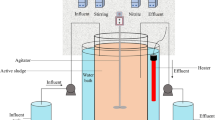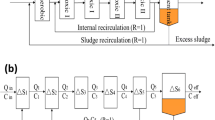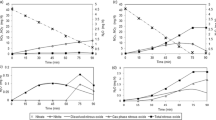Abstract
Despite the many benefits of denitrifying phosphorus removal process, the significant generation of nitrous oxide (N2O), a potent greenhouse gas, remains a problem for this innovative and promising process. To better understand and more effectively control N2O generation in denitrifying phosphorus removal process, batch experiments were carried out to investigate the main causes of N2O generation, based on which the control measures were subsequently proposed. The results showed that N2O generation accounted for 0.41 % of the total nitrogen removal in denitrifying phosphorus removal process, whereas, in contrast, almost no N2O was generated in conventional denitrification process. It was further demonstrated that the weak competition of N2O reductase for electrons and the high nitrite accumulation were the two main causes for N2O generation, evidenced by N2O production and reduction rates under different conditions. Accordingly, the reduction of N2O generation was successfully achieved via two control measures: (1) the use of continuous nitrate addition reducing N2O generation by around 91.4 % and (2) the use of propionate as the carbon source reducing N2O generation by around 69.8 %.







Similar content being viewed by others
References
Carvalho G, Lemos PC, Oehmen A, Reis MAM (2007) Denitrifying phosphorus removal: linking the process performance with the microbial community structure. Water Res 41:4383–4396
Hu Z, Zhang J, Xie HJ, Li SP, Wang JH, Zhang TT (2011a) Effect of anoxic/aerobic phase fraction on N2O emission in a sequencing batch reactor under low temperature. Bioresour Technol 102:5486–5491
Hu Z, Zhang J, Xie HJ, Li SP, Zhang TT, Wang JH (2011b) Identifying sources of nitrous oxide emission in anoxic/aerobic sequencing batch reactors (A/O SBRs) acclimated in different aeration rates. Enzyme Microb Technol 49:237–245
IPCC (2007) Changes in atmospheric constituents and in radiative forcing. In: Solomon S et al (eds) Climate change 2007: the physical science basis. Contribution of working group I to the fourth assessment report of the Intergovernmental Panel on Climate Change. Cambridge University Press, Cambridge, pp 114–143
Itokawa H, Hanaki K, Matsuo T (2001) Nitrous oxide production in high-loading biological nitrogen removal process under low COD/N ratio condition. Water Res 35:657–664
Jia WL, Zhang J, Xie HJ, Yan YJ, Wang JH, Zhao YX, Xu XL (2012) Effect of PHB and oxygen uptake rate on nitrous oxide emission during simultaneous nitrification denitrification process. Bioresour Technol 113:232–238
Kampschreur MJ, Temmink H, Kleerebezem R, Jetten MSM, van Loosdrecht MCM (2009) Nitrous oxide emission during wastewater treatment. Water Res 43:4093–4103
Kuba T, van Loosdrecht MCM, Heijnen JJ (1996) Phosphorus and nitrogen removal with minimal cod requirement by integration of denitrifying dephosphatation and nitrification in a two-sludge system. Water Res 30:1702–1710
Lemaire R, Meyer R, Taske A, Crocetti GR, Keller J, Yuan ZG (2006) Identifying causes for N2O accumulation in a lab-scale sequencing batch reactor performing simultaneous nitrification, denitrification and phosphorus removal. J Biotechnol 122:62–72
Li HJ, Chen XR, Chen YG (2010) Effect of the addition of organic carbon sources on nitrous oxide emission in anaerobic-aerobic (low dissolved oxygen) sequencing batch reactors. Front Environ Sci Engin China 4:490–499
Meyer RL, Zeng RJ, Giugliano V, Blackall LL (2005) Challenges for simultaneous nitrification, denitrification, and phosphorus removal in microbial aggregates: mass transfer limitation and nitrous oxide production. FEMS Microbiol Ecol 52:329–338
Oehmen A, Keller-Lehmann B, Zeng RJ, Yuan ZG, Keller J (2005) Optimisation of poly-beta-hydroxyalkanoate analysis using gas chromatography for enhanced biological phosphorus removal systems. J Chromatogr A 1070:131–136
Oehmen A, Lemos PC, Carvalho G, Yuan ZG, Keller J, Blackall LL, Reis MAM (2007) Advances in enhanced biological phosphorus removal: from micro to macro scale. Water Res 41:2271–2300
Pan YT, Ye L, Ni BJ, Yuan ZG (2012) Effect of pH on N2O reduction and accumulation during denitrification by methanol utilizing denitrifiers. Water Res 46:4832–4840
Ravishankara AR, Daniel JS, Portmann RW (2009) Nitrous oxide (N2O): the dominant ozone-depleting substance emitted in the 21st century. Science 326:123–125
Schalk-Otte S, Seviour RJ, Kuenen JG, Jetten MSM (2000) Nitrous oxide (N2O) production by Alcaligenes faecalis during feast and famine regimes. Water Res 34:2080–2088
Tallec G, Garnier J, Billen G, Gousailles M (2006) Nitrous oxide emissions from secondary activated sludge in nitrifying conditions of urban wastewater treatment plants: effect of oxygenation level. Water Res 40:2972–2980
Third KA, Burnett N, Cord-Ruwisch R (2003) Simultaneous nitrification and denitrification using stored substrate (PHB) as the electron donor in an SBR. Biotechnol Bioeng 83:706–720
Wang YY, Peng YZ, Stephenson T (2009) Effect of influent nutrient ratios and hydraulic retention time (HRT) on simultaneous phosphorus and nitrogen removal in a two-sludge sequencing batch reactor process. Bioresour Technol 100:3506–3512
Wang YY, Geng JJ, Guo G, Wang C, Liu SH (2011a) N2O production in anaerobic/anoxic denitrifying phosphorus removal process: the effects of carbon sources shock. Chem Eng J 172:999–1007
Wang YY, Geng JJ, Ren ZJ, He WT, Xing MY, Wu M, Chen SW (2011b) Effect of anaerobic reaction time on denitrifying phosphorus removal and N2O production. Bioresour Technol 102:5674–5684
Wunderlin P, Mohn J, Joss A, Emmenegger L, Siegrist H (2012) Mechanisms of N2O production in biological wastewater treatment under nitrifying and denitrifying conditions. Water Res 46:1027–1037
Yang Q, Liu XH, Peng CY, Wang SY, Sun HW, Peng YZ (2009) N2O production during nitrogen removal via nitrite from domestic wastewater: main sources and control method. Environ Sci Technol 43:9400–9406
Zeng RJ, Saunders AM, Yuan ZG, Blackall LL, Keller J (2003) Identification and comparison of aerobic and denitrifying polyphosphate-accumulating organisms. Biotechnol Bioeng 83:140–148
Zhou Y, Pijuan M, Zeng RJ, Yuan ZG (2008a) Free nitrous acid inhibition on nitrous oxide reduction by a denitrifying-enhanced biological phosphorus removal sludge. Environ Sci Technol 42:8260–8265
Zhou Y, Pijuan M, Yuan ZG (2008b) Development of a 2-sludge, 3-stage system for nitrogen and phosphorous removal from nutrient-rich wastewater using granular sludge and biofilms. Water Res 42:3207–3217
Zhou Y, Oehmen A, Lim M, Vadivelu V, Ng WJ (2011) The role of nitrite and free nitrous acid (FNA) in wastewater treatment plants. Water Res 45:4672–4682
Zhou Y, Lim M, Harjono S, Ng WJ (2012) Nitrous oxide emission by denitrifying phosphorus removal culture using polyhydroxyalkanoates as carbon source. J Environ Sci-China 24:1616–1623
Zhu XY, Chen YG (2011) Reduction of N2O and NO generation in anaerobic–aerobic (low dissolved oxygen) biological wastewater treatment process by using sludge alkaline fermentation liquid. Environ Sci Technol 45:2137–2143
Zhu XY, Chen YG, Chen H, Li X, Peng YZ, Wang SY (2012) Minimizing nitrous oxide in biological nutrient removal from municipal wastewater by controlling copper ion concentrations. Appl Microbiol Biotechnol. doi:10.1007/s00253-012-3988-1
Acknowledgments
This work was supported by Natural Science Foundation for Distinguished Young Scholars of Shandong province (number JQ201216), National Natural Science Foundation of China (numbers 21177075, 21007032, and 50908133), Program for New Century Excellent Talents in University (number NCET-10-0554).
Author information
Authors and Affiliations
Corresponding author
Additional information
Responsible editor: Philippe Garrigues
C. Li and J. Zhang contributed equally to this work.
Rights and permissions
About this article
Cite this article
Li, C., Zhang, J., Liang, S. et al. Nitrous oxide generation in denitrifying phosphorus removal process: main causes and control measures. Environ Sci Pollut Res 20, 5353–5360 (2013). https://doi.org/10.1007/s11356-013-1530-3
Received:
Accepted:
Published:
Issue Date:
DOI: https://doi.org/10.1007/s11356-013-1530-3




